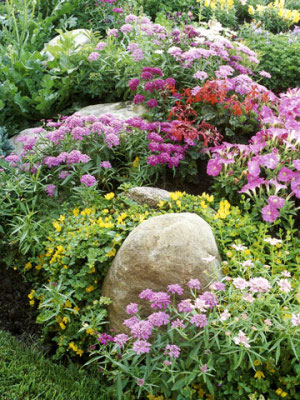
Cottage garden flowers
 I
wrote earlier that traditional
cottage garden plants were primarily
edibles or medicinals,
but some flowers were included just for
prettiness. Cottagers couldn't afford to buy flowers, but they
often dug up pretty wildflowers to transplant into their garden, or
traded plants with their neighbors. The flowers in a traditional
cottage garden sound exactly like the flowers I allow in my garden ---
they were easy to propagate and often self-sowed, needing little care.
I
wrote earlier that traditional
cottage garden plants were primarily
edibles or medicinals,
but some flowers were included just for
prettiness. Cottagers couldn't afford to buy flowers, but they
often dug up pretty wildflowers to transplant into their garden, or
traded plants with their neighbors. The flowers in a traditional
cottage garden sound exactly like the flowers I allow in my garden ---
they were easy to propagate and often self-sowed, needing little care.
The close spacing of
flowers in the cottage garden helped minimize the
amount of time the cottager spent weeding since the flowers choked out
any weeds. Forest gardeners use this same technique, talking
about filling all unoccupied niches so that unwanted plants don't have
any space to gain a foothold.
I'm unlikely to focus on
flowers anytime soon, but I have started setting aside patches for
self-seeding annuals like cosmos and fennel and have some spring bulbs
that require very little care. I like to think that my garden is
more closely akin to the traditional cottage garden than modern
"cottage gardens" are, complete with fruit trees, herbs, lots of
vegetables, bees, and chickens. All I need is a pig.
| This post is part of our Cottage Garden lunchtime series.
Read all of the entries: |
Want more in-depth information? Browse through our books.
Or explore more posts by date or by subject.
About us: Anna Hess and Mark Hamilton spent over a decade living self-sufficiently in the mountains of Virginia before moving north to start over from scratch in the foothills of Ohio. They've experimented with permaculture, no-till gardening, trailersteading, home-based microbusinesses and much more, writing about their adventures in both blogs and books.
Want to be notified when new comments are posted on this page? Click on the RSS button after you add a comment to subscribe to the comment feed, or simply check the box beside "email replies to me" while writing your comment.

You're totally right --- not quite sure what I was thinking calling fennel an annual. I tend to ignore my flowers, as you can tell. I put the fennel off in a corner and just let it do its thing, weeding it once a year if I'm lucky.
I don't really go for companion planting in the vegetable garden. My beds are small enough that I find it's better to just mix up plants between beds rather than within beds. The latter messes with my rotation schemes, and I tend to plant things too closely.